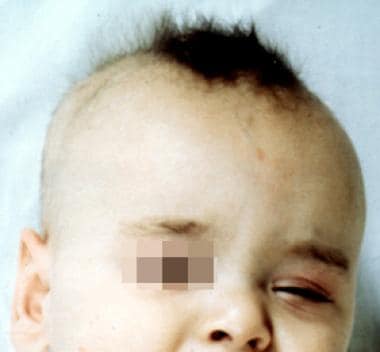Background
Menkes kinky hair syndrome is an X-linked recessive multisystemic lethal disorder of copper metabolism. The clinical phenotype is marked by fine silvery wiry hair, doughy skin, connective-tissue disturbances, and progressive neurologic deterioration. In 1962, Menkes et al [1] first described the syndrome, and, 10 years later, Danks et al [2, 3] noted the association with copper metabolism. The affected copper-transporting p-type ATPase (ATP7A) gene was cloned in 1993.
In Menkes kinky hair syndrome, intestinal copper uptake by brush border cells is normal, but copper transport to other tissues is affected. [4] This change alters the activities of various copper-dependent metalloenzymes. Male infants who are affected typically die by the time they are aged 2-3 years. Carrier female patients may have only a hair-shaft abnormality (ie, pili torti).
See the image below.
Pathophysiology
In Menkes kinky hair syndrome, a defect in intestinal copper transport with associated low serum copper and ceruloplasmin levels results in a deficiency in copper-dependent enzyme activity. Copper-dependent metalloenzymes relevant to the clinical phenotype include tyrosinase (pigmentation of skin and hair), lysyl oxidase (elastin and collagen cross-linking), ascorbate oxidase (skeletal development), monoamine oxidase (possibly responsible for pili torti), superoxide dismutase (free-radical detoxification), dopamine beta-hydroxylase (catecholamine production), peptidyl-glycine alpha-amidating mono-oxygenase (bioactivation of peptide hormones), and cytochrome c oxidase (electron transport and possibly responsible for hypothermia). The resulting defects are reflected in the clinical phenotype.
Etiology
Menkes kinky hair syndrome is a genodermatosis. [5] The gene locus for Menkes kinky hair syndrome is in band Xq13.3. Mutations at band Xq13.3 result in increased copper uptake in the small intestine, but an inability to transport copper from the brush border intestinal cells into the plasma results in a total-body copper deficiency. [6, 7, 8]
The defective protein is a copper-binding ATPase, ATP7A, localized to the trans-Golgi apparatus. The defective protein is present in all tissues, although it is barely detectable in hepatocytes. [9, 10, 11, 12] Differences in ATP7A gene expression underlie intrafamilial clinical and biochemical phenotype variability. [13, 14, 15, 16, 17]
Epidemiology
Frequency
In Australia, Menkes kinky hair syndrome occurs in 1 case per 35,000 population. Worldwide, Menkes kinky hair syndrome occurs in 1 case per 300,000 population.
Race
No racial predilection exists for Menkes kinky hair syndrome.
Sex
The phenotype of Menkes kinky hair syndrome is manifest in male patients.
Female carriers may have pili torti and uneven skin pigmentation, which appears unilaterally or along the lines of Blaschko.
Age
Symptoms of Menkes kinky hair syndrome are noted within the patient's first few months of life. Typical initial signs are hypotonia, failure to thrive, and seizures.
Seizures usually begin within the patient's first few days or months of life. Hypotonia and developmental delays are typically noted during the patient's first year of life.
Hair changes are usually not present at birth but manifest soon thereafter. Not all hairs are affected. Scalp and eyebrow hairs are most commonly short; sparse; coarse; steel wool–like; and white, silver, or gray.
Prognosis
The prognosis for Menkes kinky hair syndrome is poor. Progressive neurologic deterioration occurs in persons with Menkes kinky hair syndrome. Death, usually due to pneumonia, occurs by the time the patient is aged 2-3 years.
Patient Education
Genetic counseling is indicated in Menkes kinky hair syndrome.
-
Classic menkes kinky hair disease in an 8-month-old male infant.











